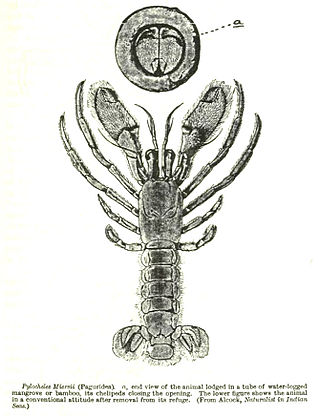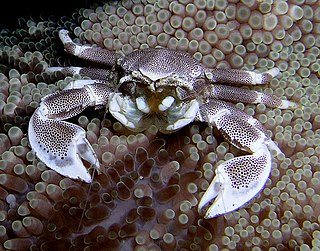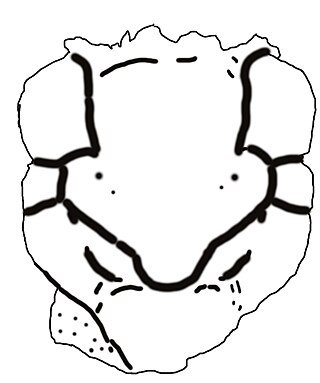
Hermit crabs are anomuran decapod crustaceans of the superfamily Paguroidea that have adapted to occupy empty scavenged mollusc shells to protect their fragile exoskeletons. There are over 800 species of hermit crab, most of which possess an asymmetric abdomen concealed by a snug-fitting shell. Hermit crabs' soft (non-calcified) abdominal exoskeleton means they must occupy shelter produced by other organisms or risk being defenseless.

Hippoidea is a superfamily of decapod crustaceans known as mole crabs or sand crabs.
The Paw Paw Formation is a geological formation in Texas whose strata date back to the late Albian stage of the Early Cretaceous. Dinosaur remains are among the fossils that have been recovered from the formation.

Albunea is a genus of mole crab within the Albuneidae. Little is known about this group's biology. A. groeningi is named after Matt Groening, creator of The Simpsons.

The Pylochelidae are a family of hermit crabs. Its members are commonly called the 'symmetrical hermit crabs'. They live in all the world's oceans, except the Arctic and the Antarctic, at depths of 2,000 m (6,600 ft). Due to their cryptic nature and relative scarcity, only around 60 specimens had been collected before 1987, when a monograph was published detailing a further 400.

Hippidae is a family of decapod crustaceans, currently known by the English name as either mole crab or sand crab, and by an earlier English name as sand bug. They are closely related to the family Albuneidae, with which they are usually joined in the superfamily Hippoidea. The family Hippidae comprises the three genera Emerita, Hippa and Mastigochirus. They burrow into sand, and are found throughout the world, except the Arctic and Antarctic.

The Galatheoidea are a superfamily of decapod crustaceans comprising the porcelain crabs and some squat lobsters. Squat lobsters within the three families of the superfamily Chirostyloidea are not closely related to the squat lobsters within the Galatheoidea. The fossil record of the superfamily extends back to the Middle Jurassic genus Palaeomunidopsis.

Cyclida is an extinct order of crab-like fossil arthropods that lived from the Carboniferous to the Jurassic and possibly Cretaceous. Their classification is uncertain, but they are generally interpreted as crustaceans, likely belonging to the superclass Multicrustacea.
Mesoparapylocheles is an extinct hermit crab genus which existed during the Mesozoic in what is now Europe. It was described by René H.B. Fraaije, Adiël A. Klompmaker and Pedro Artal in 2012. The type species is Mesoparapylocheles michaeljacksoni from the Albian or Cenomanian of Spain; which was named after the singer Michael Jackson. Genus also includes other species from the Late Jurassic (Kimmeridgian) of Germany and from the Late Jurassic (Tithonian) of Austria.

Mesoparapylocheles michaeljacksoni is an extinct hermit crab species that existed during the Albian or Cenomanian in what is now Spain. It is the type species of the genus Mesoparapylocheles. It was described by René H.B. Fraaije, Adiël A. Klompmaker and Pedro Artal in 2012, and was named after the singer Michael Jackson as it was discovered on June 25, 2009, the day Jackson died.

Blepharipodidae is a family of sand crabs (Hippoidea), comprising the two genera Blepharipoda and Lophomastix. They are distinguished from the other families in the superfamily Hippoidea by the form of the gills, which are trichobranchiate (filamentous) in Blepharipodidae, but phyllobranchiate (lamellar) in Albuneidae and Hippidae. Fossils belonging to the genus Lophomastix have been found in rocks dating back to the Eocene.

Albunea carabus is a rare species of "sand crab" or "mole crab" in the family Albuneidae. It lives in shallow, turbulent waters in sandy areas of the tropical eastern Atlantic Ocean and the Mediterranean Sea.
This list of fossil arthropods described in 2013 is a list of new taxa of trilobites, fossil insects, crustaceans, arachnids and other fossil arthropods of every kind that have been described during the year 2013. The list only includes taxa at the level of genus or species.
This list of fossil arthropods described in 2014 is a list of new taxa of trilobites, fossil insects, crustaceans, arachnids and other fossil arthropods of every kind that have been described during the year 2014. The list only includes taxa at the level of genus or species.
This list of fossil arthropods described in 2015 is a list of new taxa of trilobites, fossil insects, crustaceans, arachnids and other fossil arthropods of every kind that have been described during the year 2015. The list only includes taxa at the level of genus or species.
This list of fossil arthropods described in 2016 is a list of new taxa of trilobites, fossil insects, crustaceans, arachnids and other fossil arthropods of every kind that have been described during the year 2016, as well as other significant discoveries and events related to arthropod paleontology that occurred in the year 2016.
This list of fossil arthropods described in 2017 is a list of new taxa of trilobites, fossil insects, crustaceans, arachnids and other fossil arthropods of every kind that are scheduled to be described during the year 2017, as well as other significant discoveries and events related to arthropod paleontology that are scheduled to occur in the year 2017.
This list of fossil arthropods described in 2019 is a list of new taxa of trilobites, fossil insects, crustaceans, arachnids and other fossil arthropods of every kind that are scheduled to be described during the year 2019, as well as other significant discoveries and events related to arthropod paleontology that are scheduled to occur in the year 2019.
2020 in arthropod paleontology is a list of new arthropod fossil taxa, including arachnids, crustaceans, insects, trilobites, and other arthropods that were announced or described, as well as other significant arthropod paleontological discoveries and events which occurred in 2020.
2023 in arthropod paleontology is a list of new arthropod fossil taxa, including arachnids, crustaceans, trilobites, and other arthropods that were announced or described, as well as other significant arthropod paleontological discoveries and events which occurred in 2023.








